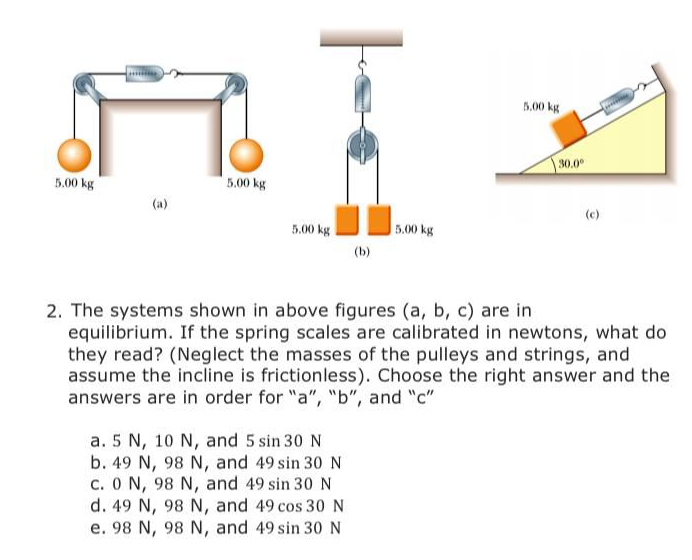The systems shown in above figures (a, b, c) are in equilibrium. If the spring scales are calibrated in newtons, what do they read? (Neglect the masses of the pulleys and strings, and assume the incline is frictionless). Choose the right answer and the answers are in order for a , b , and "c"
The systems shown in above figures (a, b, c) are in equilibrium. If the spring scales are calibrated in newtons, what do they read? (Neglect the masses of the pulleys and strings, and assume the incline is frictionless). Choose the right answer and the answers are in order for a , b , and "c"
University Physics Volume 1
18th Edition
ISBN:9781938168277
Author:William Moebs, Samuel J. Ling, Jeff Sanny
Publisher:William Moebs, Samuel J. Ling, Jeff Sanny
Chapter2: Vectors
Section: Chapter Questions
Problem 26P: In a tug-of-war game on one campus, 15 students pull on a rope at both ends in an effort to displace...
Related questions
Question
The systems shown in above figures (a, b, c) are in equilibrium. If the spring scales are calibrated in newtons, what do they read? (Neglect the masses of the pulleys and strings, and assume the incline is frictionless). Choose the right answer and the answers are in order for a , b , and "c"

Transcribed Image Text:5.00 kg
30.0°
5.00 kg
5.00 kg
(a)
(c)
5.00 kg
5.00 kg
(b)
2. The systems shown in above figures (a, b, c) are in
equilibrium. If the spring scales are calibrated in newtons, what do
they read? (Neglect the masses of the pulleys and strings, and
assume the incline is frictionless). Choose the right answer and the
answers are in order for "a", "b", and "c"
a. 5 N, 10 N, and 5 sin 30 N
b. 49 N, 98 N, and 49 sin 30 N
c. 0 N, 98 N, and 49 sin 30 N
d. 49 N, 98 N, and 49 cos 30 N
e. 98 N, 98 N, and 49 sin 30 N
Expert Solution
This question has been solved!
Explore an expertly crafted, step-by-step solution for a thorough understanding of key concepts.
This is a popular solution!
Trending now
This is a popular solution!
Step by step
Solved in 3 steps

Knowledge Booster
Learn more about
Need a deep-dive on the concept behind this application? Look no further. Learn more about this topic, physics and related others by exploring similar questions and additional content below.Recommended textbooks for you

University Physics Volume 1
Physics
ISBN:
9781938168277
Author:
William Moebs, Samuel J. Ling, Jeff Sanny
Publisher:
OpenStax - Rice University

An Introduction to Physical Science
Physics
ISBN:
9781305079137
Author:
James Shipman, Jerry D. Wilson, Charles A. Higgins, Omar Torres
Publisher:
Cengage Learning

University Physics Volume 1
Physics
ISBN:
9781938168277
Author:
William Moebs, Samuel J. Ling, Jeff Sanny
Publisher:
OpenStax - Rice University

An Introduction to Physical Science
Physics
ISBN:
9781305079137
Author:
James Shipman, Jerry D. Wilson, Charles A. Higgins, Omar Torres
Publisher:
Cengage Learning